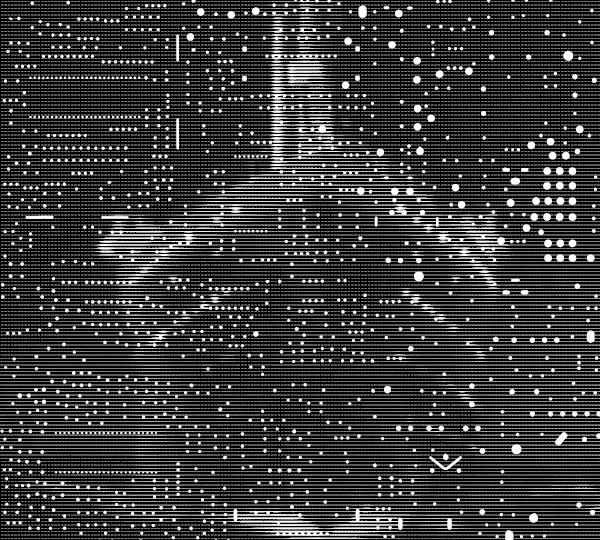Posted by Tibi in TilePage
The “Randomly Accessed Memories” works combine traditional, hundred-plus year old, cross-stitch patterns from Romania (patterns I remember from my grandparents village) with new technologies, such as custom-designed circuit boards (my college specialization, which allowed me to find a new home in United States). They are inspired by the manufacturing methods of old (1950’s-1960’s) core computer memories, as well as by the ubiquitous prototype boards used by electronic enthusiasts to test their ideas.
Posted by Tibi in TilePage
The works in this series are created from the computer models of some of the “PCB Drawings.” They are part of an ongoing exploration of the connections between textile manufacturing and the computing/electronics industry. Jacquard looms were the first automatically controlled machines ever created. Their design inspired the first attempt at building a computer, the Babbage Analytical Engine. Their control mechanism, punched cards, was used for decades in modern electronic computers. Furthermore, for many years, early electronic computers were built using “weave routing,” a method of connecting components together which…read more
Posted by Tibi in TilePage
The “Circuit Floorplan” series is inspired by common symbols from electronic design. The schematic and the layout design are the two main stages in electronic board design. In the schematic stage, the circuit is drawn and verified for electrical correctness; in the layout stage, the circuit is laid out as a circuit board and verified for mechanical correctness. “Floorplaning” is a stage in between these two, where a drawing is created to indicate general areas where blocks of circuitry are to be placed on the board, thus bridging the gap…read more
Posted by Tibi in TilePage
The “PCB Drawing” series explores how electronic design software can be used to create art. These works are manufactured using the same process as actual electronic circuit boards; unlike them, the PCB drawings are not functional, and instead they are meant to be displayed and experienced as art objects. These works start with a model created using specialized software for electronic circuit board design. The model is then sent to a factory, which returns a number of manufactured boards. Thus, each ‘drawing’ is produced as multiples, which closely relates these…read more
Posted by Tibi in TilePage
“One Second (Twitted)” is net-based project which stretches one second long piece of computation to more than a millennium. In more detail, the project tweets all Intel assembly instructions executed in one second on a Windows PC. Approximately 433 million assembly instructions were collected while running ‘ffmpeg‘ to extract the video frames used in the Origins project. It just happened that the total running time for the application was one second on a Windows 8.1 machine, running on an Intel Core i7-4510U CPU @ 2.00GHz, with 16GB of RAM. The…read more
Posted by Tibi in TilePage
The “Origins” lithograph series is based on the frames of a one second VHS video. Its creation process hints at how each frame was originally just a set of electronic signals on a circuit board. For each print, a video frame is first half-toned. Separately, the letterpress-printed shape of an actual VHS circuit board is scanned and a mask is created out of it. Finally, this mask is applied to each half-toned image to create the print. These prints match exactly the size of the main circuit board from an…read more
Posted by Tibi in TilePage
The “Movement” series turns the frames of a one second of digital video into 24 lithographs. A half-tone pattern is applied to each frame. However, the orientation of the pattern moves clockwise (thus the name) from one print to another, thus hinting at the passage of time happening between successive frames. These prints are the size of a laptop screen (9.25×15”), the most common medium for viewing videos today. The following two animated GIF’s visualize the succession of prints in the series, first the whole prints, and then a smaller, enhanced-detail one, which shows…read more
Posted by Tibi in TilePage
These works refer to an abstract quality always present in mathematical equations, starting with the use of abstract names for variables/functions, and all the way to the whole layout of mathematical symbols in an equation. These works start with visually interesting equation fragments which are then further abstracted by replacing the mathematical symbols with monoprints off two pieces of found wood augmented with ink and graphite drawings.
Posted by Tibi in TilePage
This collaborative project is inspired by the way internet memes start with a simple image (or video, or some other visual unit) that is then remixed by a lot of people who are spread out geographically. The project tries to capture this diffuse, spread out authorship. The twist here, though, is that the “remixes” are based on an analog image printed from a woodcut — probably the oldest method of producing multiples. The original image, entitled “Calm Waters”, was part of a print exchange between Platetone Printshop from Nashville, TN…read more
Posted by Tibi in TilePage
The starting point for these maps is found in the shapes and contours of printed circuit boards and other electronic components; by adding a topographic layer on top of them, they are transformed into maps. These electronic components can become topological maps, detailed city plans, sky maps, or nighttime satellite views; the transformation process consists of selecting and enlarging relevant details, letterpress printing entire circuit boards, and finalizing the map with drawing or painting. In the process, these works blur the boundaries between the man-made and the natural, reimagining the…read more









